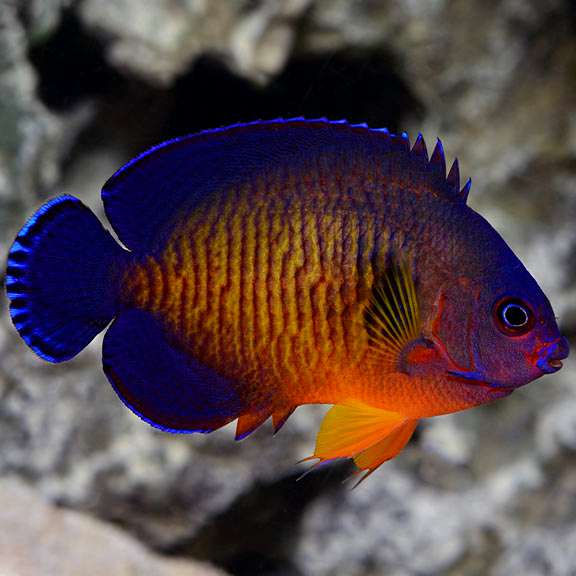
Size
3.9 inches
Physical characteristics and behavior
The majority of the Coral Beauties’ hue is a dark purple-blue. The orange vertical bars on their sides provide a visual clue. The dorsal, caudal, and anal fins are bordered with a dazzling blue band. The dorsal fin has fourteen rays, compared to the anal fin’s three spines and 17–19 soft rays. This species’ longest individuals are 10 cm in length (3.9 in).
As Pet

- Care of Aquariums
The Coral Beauty demands clean water but is less finicky than some of the other angelfish species. In order to maintain nitrate levels low, water changes of 30% per month or 15% every two weeks are ideal. If the aquarium contains corals, 20% every month, 10% every two weeks, or 5% every week work excellent. Naturally, keeping track of your water tests will allow you to determine when your tank requires a water change.
Water Changes: A 10% to 15% water change every two weeks is recommended to maintain the water clean, unless the tank holds more than 100 gallons in which case a 20% change should be made every three to four weeks.
- Setup of an aquarium
The pygmy angel prefers to forage for natural foods in places with a lot of rockwork, live rock, and rubble. To feel safe, they require a number of caverns and cracks in the rock formations to hide in. For a single Coral Beauty, the tank must hold at least 30 gallons, and for a pair, 75 to 100 gallons (283 to 378 l). Water should have the following specifications: sg 1.023–1.025, pH 8.0–8.4, and 72–81°F. They often ignore corals and other fish in bigger aquariums, but in smaller tanks, they can become highly territorial and aggressive. It is advisable to bring this dwarf angel into a decent, established tank as the final resident.
- The minimum tank size is 55 gallons (208 l), while the minimum tank size for a pair of Coral Beautys is 75 to 100 gallons (283 to 378 l).
- Appropriate for Nano Tank: Not a Live Rock Condition: Typical Plus Hiding Spots – Hiding spots are essential for dwarf angelfish to feel safe. It’s also crucial to have a sufficient quantity of living rock to provide natural meals.
- Substrate Type: Any. They do enjoy regions of rock rubble with algae growth and other goodies to eat.
- Lighting requirements: Any – With its natural deep water environment, dim or blue lighting predominates to aid in spawning. Alternately, use moderate lighting to promote the growth of algae.
- Temperature: 21.1 to 27.8 °C (70.0 to 82.0 °F)
- Hatching occurs 16 hours after spawning at a temperature of 77°F, the breeding temperature. If the water is cooler, longer. A deeper tank is required since in nature they reproduce in lower coral reef areas.
- Angelfish do not thrive over the long run at specific gravities lower than 1.023.
- pH: 8.0–8.4 range Brackish: No
- Water Movement: Any – They like some regions where the water moves more quickly.
- Water Region: Bottom – They will also live in the tank’s middle levels.
Table





